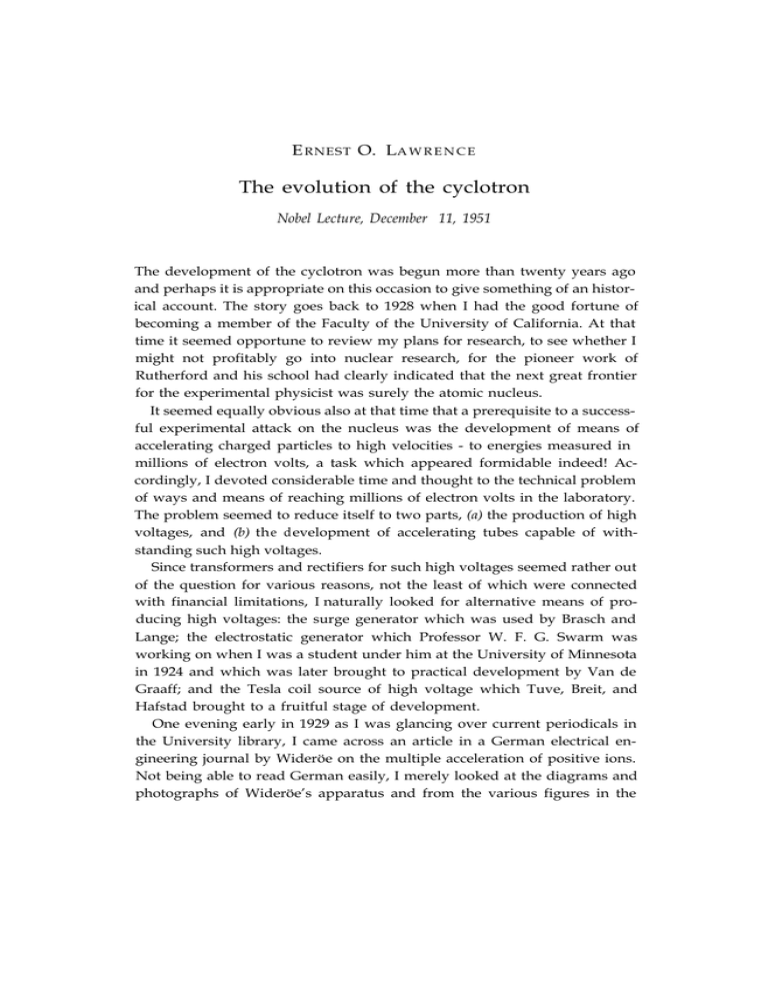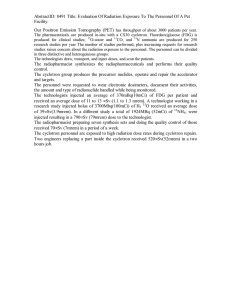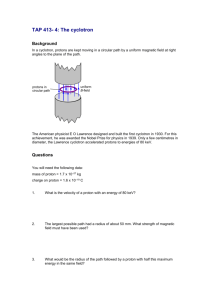Ernest O. Lawrence - Nobel Lecture
advertisement

E RNEST O. LA W R E N C E The evolution of the cyclotron Nobel Lecture, December 11, 1951 The development of the cyclotron was begun more than twenty years ago and perhaps it is appropriate on this occasion to give something of an historical account. The story goes back to 1928 when I had the good fortune of becoming a member of the Faculty of the University of California. At that time it seemed opportune to review my plans for research, to see whether I might not profitably go into nuclear research, for the pioneer work of Rutherford and his school had clearly indicated that the next great frontier for the experimental physicist was surely the atomic nucleus. It seemed equally obvious also at that time that a prerequisite to a successful experimental attack on the nucleus was the development of means of accelerating charged particles to high velocities - to energies measured in millions of electron volts, a task which appeared formidable indeed! Accordingly, I devoted considerable time and thought to the technical problem of ways and means of reaching millions of electron volts in the laboratory. The problem seemed to reduce itself to two parts, (a) the production of high voltages, and (b) the development of accelerating tubes capable of withstanding such high voltages. Since transformers and rectifiers for such high voltages seemed rather out of the question for various reasons, not the least of which were connected with financial limitations, I naturally looked for alternative means of producing high voltages: the surge generator which was used by Brasch and Lange; the electrostatic generator which Professor W. F. G. Swarm was working on when I was a student under him at the University of Minnesota in 1924 and which was later brought to practical development by Van de Graaff; and the Tesla coil source of high voltage which Tuve, Breit, and Hafstad brought to a fruitful stage of development. One evening early in 1929 as I was glancing over current periodicals in the University library, I came across an article in a German electrical engineering journal by Wideröe on the multiple acceleration of positive ions. Not being able to read German easily, I merely looked at the diagrams and photographs of Wideröe’s apparatus and from the various figures in the EVOLUTION OF CYCLOTRON 431 article was able to determine his general approach to the problem - i.e. the multiple acceleration of the positive ions by appropriate application of radiofrequency oscillating voltages to a series of cylindrical electrodes in line. This new idea immediately impressed me as the real answer which I had been looking for to the technical problem of accelerating positive ions, and without looking at the article further I then and there made estimates of the general features of a linear accelerator for protons in the energy range above one million volt electrons. Simple calculations showed that the accelerator tube would be some meters in length which at that time seemed rather awkwardly long for laboratory purposes. And accordingly, I asked myself the question, instead of using a large number of cylindrical electrodes in line, might it not be possible to use two electrodes over and over again by sending the positive ions back and forth through the electrodes by some sort of appropriate magnetic field arrangement. Again a little analysis of the problem showed that a uniform magnetic field had just the right properties - that the angular velocity of the ions circulating in the field would be independent of their energy so that they would circulate back and forth between suitable hollow electrodes in resonance with an oscillating electrical field of a certain frequency which now has come to be known as the "cyclotron frequency". Now this occasion affords me a felicitous opportunity in some measure to correct an error and an injustice. For at that time I did not carefully read Wideröe’s article and note that he had gotten the idea of multiple accelera- Fig. 1. Diagram of linear accelerator from Professor G. Ising’s pioneer publication (1924) of the principle of multiple acceleration of ions. 432 1939 E.O.LAWRENCE Fig. 2. First crude models of the cyclotron constructed by Edefsen in 1930. tion of ions from one of your distinguished colleagues, Professor G. Ising, who in 1924 published this important principle. It was only after several years had passed that I became aware of Professor Ising’s prime contribution. I should like to take this opportunity to pay tribute to his work for he surely is the father of the developments of the methods of multiple acceleration. Perhaps you will permit me first of all to show a slide of the diagram of the linear accelerator in his original publication (Fig. 1). I hope I have not belabored excessively these early incidents of history and now I should like to trace rapidly the evolution of the cyclotron by showing examples of the apparatus in our laboratory as it was developed in the course of time. In doing so, I am afraid I shall not be able to mention all those who EVOLUTION OF CYCLOTRON 433 Fig. 3. Working model of cyclotron constructed by M. Stanley Livingston which pointed the way to later developments. deserve great credit for the developments - as from the beginning the work has been a team effort involving many able and devoted co-workers in many laboratories. As I am sure you will appreciate, a great many diverse talents are involved in such developments and whatever measure of success is achieved is dependent on close and effective collaboration. Although the cyclotron was, so to speak, invented early in 1929, actual experimental work on its development was begun in the spring of 1930 when one of my students, Nels Edlefsen, constructed two crude models shown in Fig. 2. One of the models which gave slight evidence of working consisted of two copper duants waxed together on a glass plate with a filament source along the diameter at the center much like later models. 434 1939 E.O.LAWRENCE In the fall, another student, M. Stanley Livingston, continued the development and quickly constructed the model shown in Fig. 3 which, as you see, had all the features of early cyclotrons and which worked very well indeed as 80,000 volt protons were produced with less than 1,000 volts on the semi-circular accelerating electrode - now called the "dee". The next milestone in the development was the construction of a larger model (Figs. 4 and 5) which produced protons of the desired energies - in the region of one million electron volts. Livingston and I had the remarkable good fortune of observing that this apparatus was rather more successful than we had expected. For, as you can well imagine, we were concerned about how many of the protons would succeed in spiralling around a great many times without getting lost on the way. We soon recognized that the focussing actions of the electric and magnetic fields were responsible for the relatively large currents of protons that reached the periphery of the apparatus; but we must acknowledge that here again experiment preceded theory! We were busy with further improvements of the apparatus to produce larger currents at higher voltages when we received word of the discovery by Cockcroft and Walton, which this year has been recognized by the Nobel Prize in Physics. We were overjoyed with this news, for it constituted definite assurance that the acceleration of charged particles to high speeds was a worth-while endeavor. As you can imagine, we went ahead with all speed, and it was not long before the disintegration of lithium by protons had been observed with the apparatus. Now we may proceed rapidly with examples of later developments. Figs. 6 and 7 show the first two-dee 27” cyclotron which produced protons and deuterons of several million volts and was used extensively in early investigations of nuclear reactions involving neutrons and artificial radioactivity. Again, with this apparatus the discoveries of Chadwick and the CurieJoliots were promptly confirmed. Indeed, looking back it is remarkable that we managed to avoid the discovery of artificial radioactivity prior to their epoch-making announcement: for we tried at first to use Geiger counters in observing nuclear radiations produced by the cyclotron and observed that their background was always variable and large. In those days Geiger counters had the reputation of being unreliable and, rather than looking into the matter of their apparent misbehavior, we turned to ion chambers and linear amplifiers to. observe heavy-particle nuclear reactions. Of course, the Geiger counters were simply being faithful to duty and recording the radiations from the artificial radioactive substances, and this became immediately ap- EVOLUTION OF CYCLOTRON Fig. 4. General view of first cyclotron used in nuclear transformations. Fig. 5. Vacuum chamber ofcyclotron (Fig. 4) which produced 1 million volt protons. 435 436 1939 E.O.LAWRENCE Fig. 6. General view of 27” cyclotron built by young physicists including M.S. Livingston (left) and E. O. Lawrence (right). (The lack of good engineering design is quite evident!) Fig. 7. The chamber of the 27” cyclotron showing two dees. EVOLUTION OF CYCLOTRON 437 Fig. 8. Early photograph of 60” cyclotron showing first evidence of good engineering practice, introduced into our laboratory by W. M. Brobeck (right) and Donald Cooksey (left). parent after the Curie-Joliot announcement. Again, we were overjoyed at the richness of the domain in the nucleus accessible to particles of several million electron volts energy and there followed a happy period of intensive experimental investigations, which indeed through the years has gained everincreasing tempo in laboratories the world over. The next milestone in our laboratory was the construction of the 60” cyclotron, and this undertaking was greatly strengthened by the joining of our team of William Brobeck, a truly outstanding engineer. Brobeck brought to our laboratory sound engineering practice which from the day he joined us has had a profound effect on developments. To him, more than to any other one individual, goes the credit for the success of the 60” cyclotron and all subsequent developments. As you can see in Fig. 8, the cyclotron for the first time began to look like a well-engineered machine. It was with this machine that the discoveries of the transuranium elements were made which have been rewarded this year by the award of the Nobel Prize in Chemistry to McMillan and Seaborg. Perhaps the finest example of a 60” 438 1939 E.O.LAWRENCE cyclotron is now in operation at the Nobel Institute here in Stockholm. Soon our objective was the production of protons and deuterons of much higher energies, and Bethe pointed out the difficulty introduced by the relativistic increase in mass of the particles as they increase in energy in the course of acceleration which causes them to get out of resonance with an oscillating electric field in a uniform magnetic field. However, Thomas devised a magnetic field that avoided the limitation discussed by Bethe, and also, of course, it was recognized that one might modulate the frequency in step with the changing angular frequency of the accelerated particles. These two solutions of the technical problem of yet higher energies - the region of 100 million volts - seemed impractical; at least much less practicable than simply so designing the cyclotron that a million volts or more could be applied to the dees, so that the particles would need to circulate around relatively few times in reaching the desired high energies. Accordingly, just before the war, Brobeck and co-workers designed the great 184” cyclotron shown in Fig. 9. As is well known, the war prevented the building of this machine and immediately afterwards McMillan, and Veksler independently a few months earlier, came forward with the principle of phase stability which transformed the conventional cyclotron to a much more powerful instrument for higher energies - the synchrocyclotron. Fig. 10 shows the main features of the Berkeley 184” synchrocyclotron which produces 340 MeV protons, while there are later and more modern installations, notably at Columbia University and University of Chicago, which produce somewhat higher energies. As I am sure this audience is well aware, a beautifully engineered synchrocyclotron is nearing completion at Uppsala. On completion of the 184” synchrocyclotron, it was natural that Brobeck should turn his attention to the engineering problem of applying the synchrotron principle to the acceleration of heavy ions, particularly protons, to much higher energies - in the range of billions of electron volts. It was not long before his engineering studies indicated the practicability of producing protons in the energy range well above one billion electron volts. With the extensive developments in the atomic energy field, large funds became available for research purposes - much larger than seemed possible before the war - and indeed, as soon as all concerned were convinced of the practicality of building a proton synchrotron for several billion electron volts, the construction of two installations was begun, one at Brookhaven for EVOLUTION OF CYCLOTRON 439 Fig. 9. Artist’s sketch of 184” cyclotron designed by Brobeck before the war to produce 100 million electron volt protons. Fig. IO. General view of 184” synchrocyclotron which produces 340 MeV protons. (The concrete shielding, partially removed in this photograph, is 15’ in thickness.) 440 1939 E.O.LAWRENCE Fig. 11. One-quarter scale operating model of 6 BeV proton synchrotron. about 3 billion electron volts and a second at Berkeley for about twice this energy. The first step in these large undertakings was to build a substantial operating model to test out the theory of the proton synchrotron, as well as the engineering principles of design. Accordingly, a quarter-scale operating model was constructed and is shown in Fig. 11. A small cyclotron was designed to produce large current pulses of I MeV protons which were injected into the "race track" of the synchrotron by an appropriate magnetic and electrostatic deflecting system which can be seen in the foreground of Fig. 11. This model worked as expected and provided a great deal of practical data giving confidence that the full-scale machines will function successfully and satisfactorily. It is hardly appropriate here to describe either the Brookhaven or Berkeley proton synchrotrons (the former is called the cosmotron and the latter is called the bevatron) but perhaps it is of interest to show a number of photographs EVOLUTION OF CYCLOTRON 441 which display the general features of this great machine (Figs. 12, 13, 14, 15 and 16). Now that we shall soon have 5 or 10 BeV particles in the laboratory, what possibilities are there for going on higher to 50 or 100 BeV? One answer is that the limitation of the bevatron is largely a financial one. With a correspondingly larger expenditure, higher energies surely can be reached. But I should like to close by emphasizing that a more feasible, if not more interesting, approach to the problem of higher-energy nuclear projectiles is the acceleration of multiply charged heavier ions such as C 6+, or Ne10+ Already extraordinarily interesting nuclear reactions have been produced by the acceleration of C6+ ions to 120 MeV in the 60” cyclotron, and such particles in the Berkeley bevatron would be accelerated to more than 36 BeV Since in the cosmic radiation such heavy particles play an important role, they will surely be produced in the bevatron some day, contributing to further progress in our understanding of Nature. Fig. 12. General view of "race track" magnet in process of assembly for 6.3 BeV proton synchrotron or "bevatron". 442 1939 E.O.LAWRENCE Fig. 13. Showing coil winding of bevatron magnet. Fig. EVOLUTION OF CYCLOTRON Fig. 15. Bevatron motor generator equipment. Fig. 16. Ignitrons and associated switchgear for bevatron motor generator. 443



